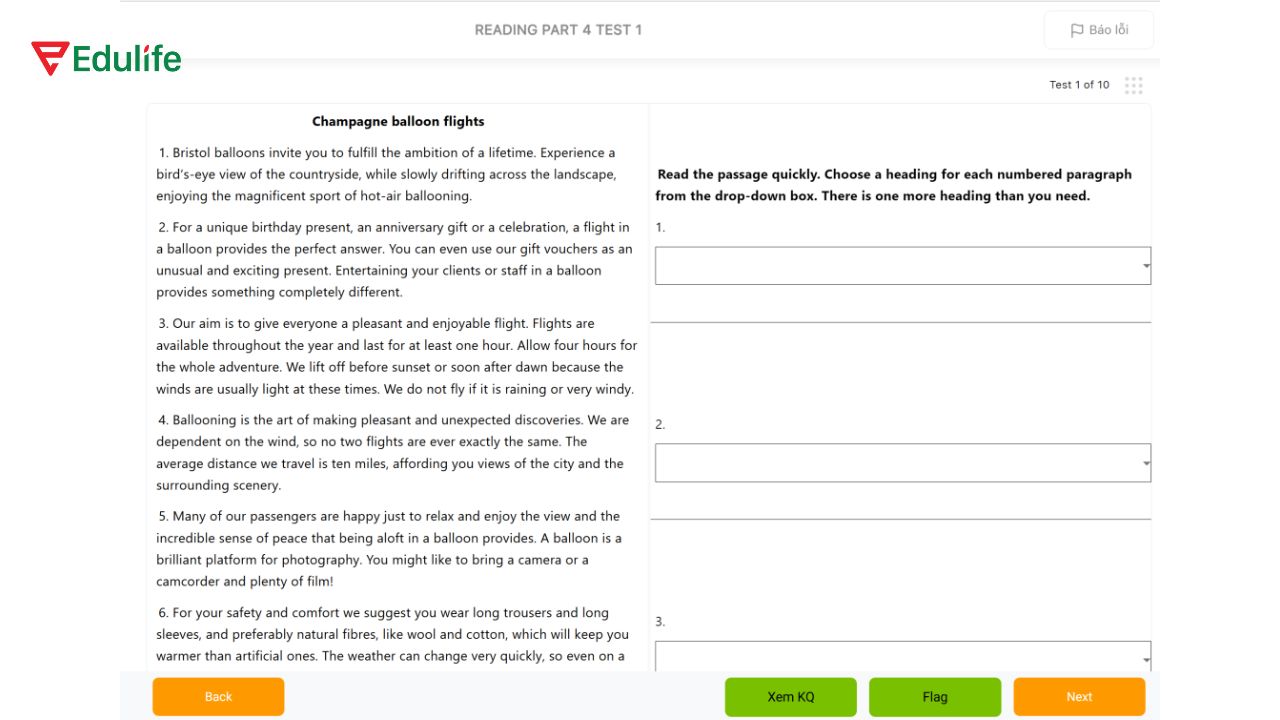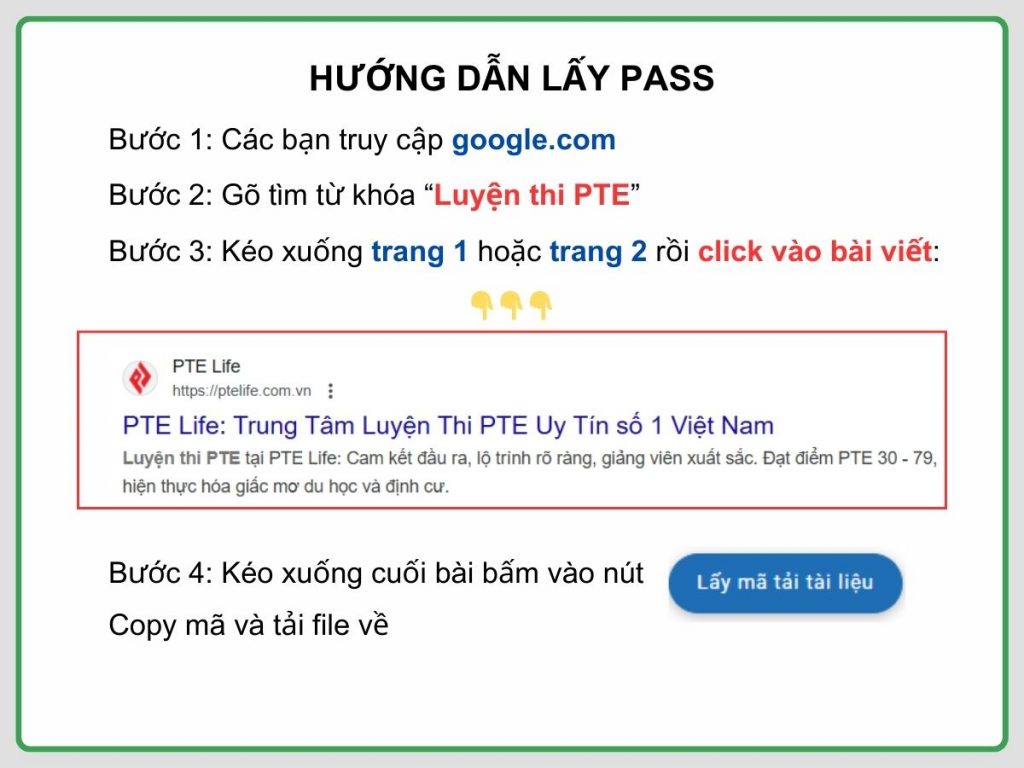Aptis Reading Part 4 là một bài thi quan trọng để kiểm tra khả năng nhận diện thông tin và kết nối ý tưởng. Hãy cùng tìm hiểu chi tiết về cấu trúc đề thi cùng các chiến lược làm bài để đạt kết quả tốt nhất qua bài viết dưới đây của Edulife.
Giới thiệu bài thi Aptis Reading Part 4
Aptis Reading Part 4 yêu cầu thí sinh đọc và phân tích một văn bản dài khoảng 750 từ. Nhiệm vụ chính là ghép 8 tiêu đề (headings) được cho sẵn với các đoạn văn tương ứng, trong đó có một tiêu đề thừa. Phần thi này đánh giá khả năng đọc hiểu và nắm bắt ý chính của thí sinh đối với những văn bản dài và phức tạp.

Aptis Reading Part 4 Sample 1
Read the text. Match the headings (A-I) to the paragraphs. The answer to question 0 is an example. There is one heading that you will not use.
(0) When you think of pizza, you probably envision a circular pie with tomato sauce, cheese and pepperoni. However, this wasn’t always the form it took. There are references to a bread served with toppings such as cheese and mushrooms dating back to ancient Greece and Rome. A mention of this meal is even mentioned in Virgil’s literary classic, The Aeneid, where the men feast on vegetable-topped bread.
(1) Although people have been enjoying a version of pizza since ancient times, modern pizza has its beginnings in Naples, Italy, dating back to the 18th century. Many people lived in poverty and needed food that was inexpensive to prepare and quick to consume. Tomatoes were a new commodity to Europe, and they were a cheap topping to add on to oven-baked flatbread. Other ingredients included lard, garlic and horse cheese. Due to the population’s on-the-go lifestyle, this food was often sold in the streets and eaten standing up.
(2) Despite this dish being associated with the lower class, a shift in opinion occurred with King Umberto I and Queen Margherita visited the city in 1889. The pair were given an assortment of pizzas to try, but the one that won the Queen over included basil, mozzarella and tomato sauce. She loved it so much that they named the pizza after her- the Margherita. Asides from the delicious combination of flavours, the colours on the pizza represent the green, white and red of the Italian flag. Shortly after the royal couple tried this regional specialty, it became a national dish.
(3) Furthermore, Italian immigrants took this recipe with them to the United States of America in the 20th century. The first pizzeria was said to have opened up in New York in 1905, fewer than 20 years after its fame in Italy. Similar restaurants in Italian-American communities began to pop up shortly after. However, the craving for pizza did not stop there. When American soldiers returned home from World War II, they desired the taste of the European delicacy they had become accustomed to while abroad. Soon, restaurants all over the nation were offering pizza on their menus.
(4) As the world became more globalized, a variety of changes to suit local tastes were introduced, much to the disapproval of the original Neapolitan founders. Moving away from the traditional shape is Chicago’s deep-dish style pizza. This dish resembles a pie, where ingredients are layered in a cake pan and baked for over 30 minutes. Some of these modifications have become internationally recognized. The infamous Hawaiian style pizza, topped with pineapple and ham, was actually invented by a Greek-immigrant in Canada in the 1960s as a unique measure to attract more customers.
(5) In addition to its ingredients, pizza also adapted to modern society. Chain restaurants, such as Pizza Hut and Dominos, began in the early 1960s and have spread around the world. The latter is even associated with the popularization of pizza delivery. It’s no surprise that today, Dominos operates in over 90 countries around the world. Concurrently, the invention of frozen pizza made its debut around this time. Consumers were now able to purchase a box of ready-made pizza from their local supermarket and heat it up at home at their leisure and convenience.
(6) The admiration for pizza did not stop in people’s stomachs. Like its mention in classical literature, it even made it onto the big screen. Who could forget Julia Roberts in Eat, Pray, Love when she tastes pizza in Naples and professes her love for it? Even fictional characters, like the Teenage Mutant Ninja Turtles were also quite fond of this meal.
(7) Today, its popularity is undisputed and you can find pizza all over the world. While ordering pineapple on a pizza will be met with disgust in Italy, Naples is making an effort to maintain the original form’s authenticity. In an effort to preserve the sanctity of its beloved dish, Italy has passed some laws claiming what truly qualifies as a Neapolitan pizza. This legislation specifically outlines the type of ingredients, oven and temperatures used to make the dish. Despite this, regional pizzas such as the thin-crust version in the Apulian region, or the square-cut Roman style are still allowed to exist without protest.
- A. Protecting a Legacy
- B. Modern Origins
- C. International Expansion
- D. Ancient Versions
- E. Pizza in Pop Culture
- F. Important Ingredients
- G. Flavour Modifications
- H. Changed Perspectives
- I. Convenient Innovations
Answer
- 0. D
- 1. B
- 2. H
- 3. C
- 4. G
- 5. I
- 6. E
- 7. A

Hướng dẫn làm bài thi & các mẹo nhỏ
Để hoàn thành tốt Aptis Reading Part 4, thí sinh cần nắm rõ cách phân tích tiêu đề và nội dung từng đoạn văn. Dưới đây là những mẹo giúp bạn tối ưu hóa bài làm.
Đọc lướt nội dung chính của bài đọc
Bắt đầu bằng cách lướt qua toàn bộ bài đọc để nắm bắt chủ đề chính và nội dung tổng quan. Điều này giúp bạn có cái nhìn bao quát về bài viết và dễ dàng liên kết các đoạn với tiêu đề sau này.

Đọc kỹ các tiêu đề
Phân tích từng tiêu đề để hiểu ý nghĩa cụ thể và xác định các từ khóa quan trọng. Những từ khóa này thường là manh mối giúp bạn tìm ra mối liên hệ với các đoạn văn.
Đọc kỹ từng đoạn và ghép nối tiêu đề phù hợp
- Đọc cẩn thận từng đoạn văn, chú ý đến các ý chính và từ khóa trong đoạn. So sánh với các tiêu đề đã phân tích để tìm sự tương đồng.
- Lưu ý các từ hoặc cụm từ đồng nghĩa giữa tiêu đề và đoạn văn. Điều này giúp bạn nhận diện đoạn văn phù hợp một cách chính xác hơn.
- Đừng quên kiểm tra lại những tiêu đề chưa được sử dụng để đảm bảo rằng tiêu đề cuối cùng là tiêu đề thừa.
Download đề thi Aptis Reading Part 4 miễn phí
Tải ngay đề thi Aptis Reading Part 4 miễn phí để ôn luyện kỹ năng đọc hiểu một cách hiệu quả. Những đề thi thực tế này sẽ giúp bạn làm quen với cấu trúc bài thi và nâng cao khả năng xử lý thông tin.

Bài viết đã cung cấp những thông tin chi tiết về phần thi Aptis Reading Part 4. Hy vọng rằng bạn đã hiểu rõ cấu trúc và phương pháp làm bài cho phần thi này. Chúc bạn tự tin và đạt được kết quả cao trong kỳ thi sắp tới!



